Scheeßel
5
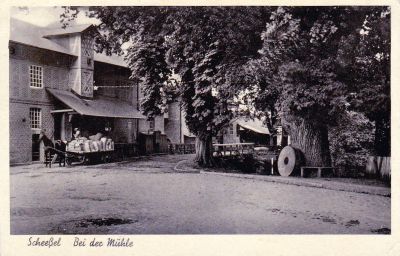
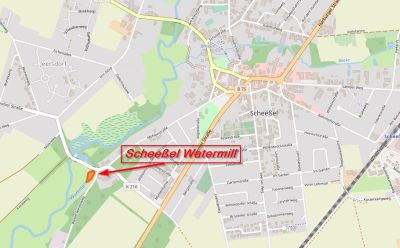
The watermill in Scheeßel is a mystical place. Its history goes back a long way; the first reliable evidence of its existence dates from the very early 16th century. And, as is the case with mystical places, legends and lore are added to the historical facts. They form the raw material for a theater production.
The old lady [mill] is said to have been erected at her current location on the Wümme in 1507 after the predecessor was destroyed. However, neither the exact date of birth of the existing one nor the history of the destruction of an earlier mill that was operated at another location can be proven historically beyond any doubt. Too many documents have disappeared over the centuries. What may cause historians a headache is a blessing for the creative. It is precisely the ambiguities, the mixing of legend and truth, that stimulate the imagination and open the door for artistic interpretation. On this humus, a much-noticed theater piece has already grown up: In September 2003, amateur actors presented the drama.[2]
The legend that has survived from ancient times, according to which disagreements between the sons of the late miller caused the demise of the first Scheeßeler mill. The younger of the two, a legendary “high-spirited, ungodly and quarrelsome man”, had dammed the water so high on Easter Sunday that it overflowed, and his goal was to “orderly” those attending the service and the pastor who he hated “To get your feet wet “. But things got out of control: like a punishment from God it happened that the dam on which the mill stood broke and let the whole building sink. The older brother, who was among the churchgoers, then grabbed his younger rival and threw him into the water so that he would never be seen again.[2]
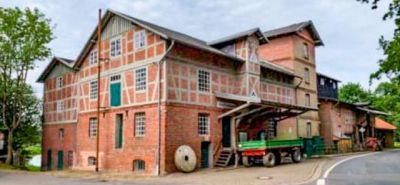
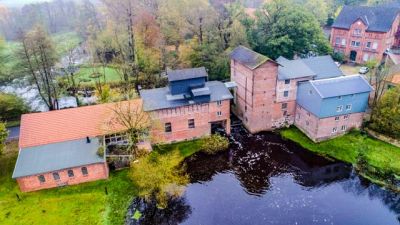
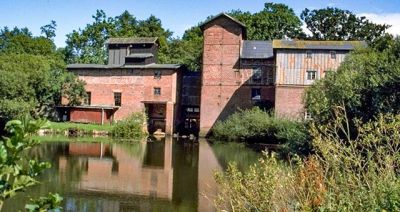
As noted, the mill was first mentioned in 1507, however the origins certainly go back even further. The mill was last rebuilt in 1830. It had two water wheels and three milling cycles. Then there were various expansion measures. 1884 and 1893 installation of two Francis shaft turbines; They were replaced in 1926 and 1929 by those with 55 or 22 kW [mill day] or 45 and 30 kW . The mill has three grinding passages, 4 pipe mixing machines, a hammer mill and a feed press. Operation ceased in 1999. It also included a sawmill (with steam operation until approx. 1936) and a grain distillery from 1866 to 1969.[3]
The Mill Operators – Müller family
The Müller[4] family [See Appendix: Müller Family History} has probably been associated with the mill since the mill was rebuilt. There is a gravestone of Johann Moller from 1607,
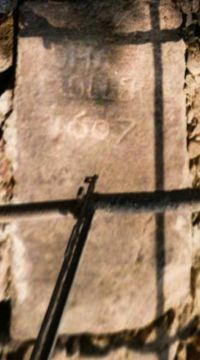
which was inserted horizontally in the St. Lucas Church – Scheeßel wall to the right of the entrance door and is believed to be on the old burial ground of the mill.
The oldest documented ancestor of the Müller family was Tönies Müller (1573-1630). According to a sales contract dated September 14, 1617, he acquired a piece of land from the Scheeßeler community and was identified as miller at the Scheeßeler mill. The mill itself was operated and leased to the miller’s family until Leopold Friedrich Wilhelm Müller bought it in 1859. In addition to the grain mill, the company previously had a considerable agricultural business, a distillery, a sawmill and a brick factory in neighboring Wersterholz. The mill is still owned by the Müller family (Müller-Scheeßel). It is no longer a commercial operation and is being restored as a historical, museum mill. A “Scheeßeler Mühle” sponsorship association assists the current owner, Dr. Jan Müller-Scheeßel in restoring the mill.[3]
In 1507 the mill was rebuilt at its current location on the Wümme. During the Thirty Years’ War the mill was destroyed again by imperial troops and then rebuilt. The former mill had two water wheels.
The miller had another grain mill built on the opposite bank of the river in 1834. The mill also had a sawmill, which had to be stopped in 1971. Both mills were given turbine operation in 1884 and 1891 instead of water wheels. The Scheeßeler Mühle is thus one of the oldest turbine mills in northern Germany.
In 1929, the mill was converted to the production of compound feed and baked meal before it was completely shut down in 1999. The development association “Scheeßeler Mühle” has been in charge of the mill since 2003 and has the goal of operating the mill as a mill museum. [5]
Additional Comments
Jan Müller-Scheessel[6] , the current mill owner and museum director, noted on review of this chapter that:
-The distillery was established before 1731. The first steam-engine for mill and distillery came in 1966. The boiler-house still exists.
-In fact, the family owned some property before 1617. This property – at least one meadow – was located in Rotenburg. So I suppose, the family originally came from Rotenburg and settled in Scheeßel perhaps after the rebuilding of the mill in 1507.
Electrical Power Generation
Electrical power generation currently provides remuneration to assist in the support of maintaining the mill as a museum.[8]
The mill has been supplying the open network with energy since 2003. If you go further into the past of local power generation, you can see that the Müller-Scheeßel family already generated electricity through hydropower in 1909. However, the first generators only supplied their own needs and the workers’ houses with electricity. It was mainly used for light in the early 20th century. Around 1930, the millers bought the first electric motors.[7]
Scheeßeler Mühle” Sponsorship association
In 2003, the Scheeßeler Mühle Association took over the building to make it accessible to interested people as a technical monument. With the great commitment of the club members and with public support, the building was renovated, the technology was made operational again and missing machines were replaced. Flour milling with technology from the first half of the 20th century can now be presented in all its complexity. This happens especially on the day of the mill, when the technology is started and the grinding of rye is demonstrated. In the case of individual mill tours offered by the association, the technology is explained and often demonstrated in action.[12][13]
In addition to restoring the watermill [14], the association provides maintenance and pest control[15], sponsors mill and fair days[16][17], writers[18], apprenticeships[19] and deals with environmental issues [20][21].
Video Tour
A video tour of the mill is available for viewing at Old Water Mill Used to Generate Electricity.[10]
Additional Comments
Jan Müller-Scheessel, the current mill owner and museum director, noted on review of this chapter that:
-The distillery was established before 1731. The first steam-engine for mill and distillery came in 1966. The boiler-house still exists.
-In fact, the family owned some property before 1617. This property – at least one meadow – was located in Rotenburg. So I suppose, the family originally came from Rotenburg and settled in Scheeßel perhaps after the rebuilding of the mill in 1507.
References and Notes
- Postcard from Scheeßel, Germany. “Bei der Mühle” (“At the Mill”). Circa 1936. Publisher: Heinrich Volckmer, Scheeßel. Downloaded from https://upload.wikimedia.org/wikipedia/commons/9/93/Schee%C3%9Fel_2.jpg 30 May 2020.
- Andre Ricci, Ancient Mill Legend Serves as a Model for a Play – Time Travel in the Fog. Rotenburger Rundschau, 27 Aug 2007 translated from https://www.rotenburger-rundschau.de/rrarchiv/scheessel/uralte-muehlensage-dient-als-vorlage-fuer-theaterstueck-von-andr-eacute-ricci-54961.html 30 May 2020.
- Jan Müller-Scheeßel, Scheeßeler Mill in Kraft- und Dampfmaschinen. translated from http://www.albert-gieseler.de/dampf_de/firmen6/firmadet60619.shtml
- Wikipedia, “The German word Müller means “miller” (as a profession). It is the most common family surname in Germany, Switzerland, and the French départements of Bas-Rhin and Moselle (with the spelling Müller, Mueller or Muller)” downloaded from https://en.wikipedia.org/wiki/M%C3%BCller_(surname) 20 June 2020.
- Museums – MILLS – Scheeßel Watermill. translated from https://www.tourow.de/aktivitaeten/kultur-und-kunst/muehlen-detailseite/poi/wassermuehle-scheessel.html 30 May 2020.
- Preserve and Use a Mill With History. Enyway Power. translated from https://www.enyway.com/de/strom-kaufen/wasser/jan-w-c-mueller-scheessel-zwischen-hamburg-und-bremen 30 May 2020.
- Joris Ujen. Jan Müller Scheeßel Produces 100,000 Kilowatt Hours a Year with his Mill. MK 4 Jul 2018. translated from https://www.kreiszeitung.de/lokales/rotenburg/scheessel-ort52321/oeko-strom-wuemmewasser-10006466.html 30 May 2020.
- Nico Schnurr, Watermill in Scheeßel. Weser Kurier 21 Jan 2019. translated from https://www.weser-kurier.de/region/niedersachsen_artikel,-revolution-von-unten-_arid,1800413.html. 30 May 2020.
- How an Old Water Mill in Scheeßel Contributes to the Energy Transition. Buten un Binnen 22 Sep 2019 translated from https://www.butenunbinnen.de/nachrichten/gesellschaft/strom-enyway-scheessel-nachhaltig-100.html 30 May 2020.
- Old Water Mill Used to Generate Electricity. YouTube 30 Jul 2015 viewed at https://youtu.be/CF1D1SHXov4?list=RDCMUCHTK-2W11Vh1V4uwofOfR4w&t=40 30 May 2020.
- Believed to be the gravestone of Johan Müller (1548-1607) . The St. Lucas Church wall is on the right next to the main entrance, where the old Müller family burial site was located. This gravestone is horizontally walled in and has the lettering “JHN MOLLER, 1607”. Jan Müller-Scheessel photographed this stone in 1990 when the church was being restored. The stone now lies hidden under the plaster facade of the church.
- Friends of the Scheeßeler Mühle. translated from https://www.muehlenverein-scheessel.de/foerderverein 30 May 2020.
- Mill friends confirm their club chairman 13 Mar 2014 translated from https://www.rotenburger-rundschau.de/rrarchiv/scheessel/-105090.html May 2020.
- Scheeßeler Mühle is being restored. translated from http://www.kleiekotzer.com/html/scheessel.html May 2020.
- Pest control in the mill is on schedule 19 Mar 2013. translated from https://www.rotenburger-rundschau.de/rrarchiv/lokales/scheessel/schaedlingsbekaempfung-in-der-muehle-liegt-im-zeitplan-97469.html 30 May 2020.
- Mill Day with Flea Market on Whit Monday, May 16 – The engine is running translated from https://www.rotenburger-rundschau.de/lokales/rotenburg-wuemme/neue-fuehrung-jan-mueller-scheessel-ist-clubchef-im-jubilaeumsjahr-116558.html 30 May 2020.
- Scheeßeler Mühlenverein presents restored Bersdorf motor at Mill Day translated from https://www.kreiszeitung.de/lokales/rotenburg/scheessel-ort52321/maennergespraeche-achttonner-8378230.html 30 May 2020.
- Raimund Herrmann, the mill writer 25 May 2014. translated from https://www.rotenburger-rundschau.de/rrarchiv/scheessel/buch-voller-kindheitsgeschichten-veroeffentlicht-106393.html 30 May 2020.
- 14-year-old Tobias Waltereit helps in the water mill – The young miller 16 Oct 2018. translated from https://www.rotenburger-rundschau.de/lokales/scheessel/der-14-jaehrige-tobias-waltereit-hilft-in-der-wassermuehle-123074.html 30 May 2020.
- Scheeßeler Mühle landed in a red folder 27 May 2014. translated from https://www.rotenburger-rundschau.de/rrarchiv/scheessel/wasserkraftnutzung-bald-nicht-mehr-erlaubt-106473.html 30 May 2020.
- Local council initiates planning approval procedure for fish ladder. 21 Oct 2014 translated from https://www.kreiszeitung.de/lokales/rotenburg/scheessel-ort52321/gemeinderat-bringt-planfeststellungsverfahren-fischtreppe-4195158.html 30 May 2020.
- Welcome to the Scheeßeler mill. translated from http://www.scheesseler-muehle.de/ 20 Jun 2020.
